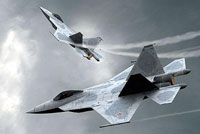Russia Delays Test Flight of Stealthy Fifth Generation Sukhoi T-50
Russia will not test its fifth-generation aircraft this outgoing year. “The tests will begin in 2010,” Vice Prime Minister Sergey Ivanov told reporters Tuesday, RIA Novosti reports.

Ivanov said in May of this year that the test flight of the state-of-the-art aircraft would begin before the end of 2009. Deputy Defense Minister Vladimir Popovkin said in June that the fifth-generation aircraft would be put into service in 2015.
Prime Minister Putin visited Russia’s largest air show MAKS in August and said that the production of the fifth-generation aircraft was a very important direction in the development of the nation’s aviation industry.
Russia ’s Sukhoi design bureau and NPO Saturn have been developing the fifth-generation fighter jet since the 1990s. It will be reportedly possible to use the fighter in all weathers, 24/7. The stealthy jet will be able to fly at an ultrasound speed and possess a highly efficient automated defense system. Only the United States of America has developed a fifth-generation fighter jet.
In the late 1980s, the Soviet Union outlined a need for a next-generation aircraft to replace its MiG-29 and Su-27 in frontline service. Two projects were proposed to meet this need, the Sukhoi Su-47 and the Mikoyan Project 1.44. In 2002, Sukhoi was chosen to lead the design for the new combat aircraft. The PAK FA will incorporate technology from both the Su-47 and the MiG 1.44.
Russia and India agreed in early 2007 to jointly study and develop a Fifth Generation Fighter Aircraft Program, FGFA. On October 27, 2007, Asia Times quoted Sukhoi's director, Mikhail Pogosyan, "We [India and Russia] will share the funding, engineering and intellectual property [of the new project] in a 50-50 proportion." The Indian version, according to the deal, will be different from the Russian version and specific to Indian requirements. While the Russian version will be a single-pilot fighter, the Indian variant will have a twin-seat configuration based on its operational doctrine which calls for greater radius of combat operations. The wings and control surfaces need to be reworked for the FGFA. Although, development work has yet to begin, the Russian side has expressed optimism that a test article will be ready for its maiden flight by 2012 induction into service by 2015.
Although there is no reliable information about the jet's specifications yet, it is known from interviews with people in the Russian Air Force that it will be stealthy, have the ability to supercruise, be outfitted with the next generation of air-to-air, air-to-surface, and air-to-ship missiles, and incorporate a fix-mounted AESA radar with a 1,500-element array. The jet will use on its first flights 2 Saturn 117S engines (about 14.5 ton thrust each). The 117S is an advanced version of the AL-31F, but built with the experience gained in the AL-41F program. The AL-41F powered the Mikoyan MFI fighter (Project/Article 1.44). Later versions of the jet will use a completely new engine (17.5 ton thrust each), developed by NPO Saturn or FGUP MMPP Salyut.
On 20 August 2009, Russian Air Force Chief Alexander Zelin said that there were problems with the engines and research was continuing.
Subscribe to Pravda.Ru Telegram channel, Facebook, RSS!



